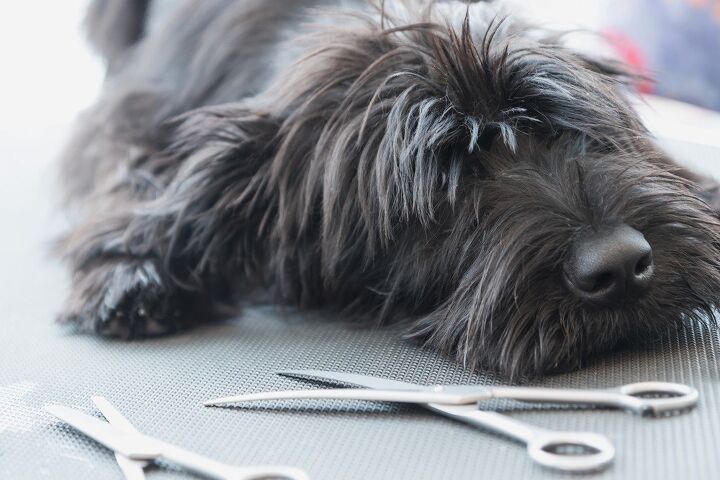When you first brought your new puppy home, you were likely picturing fluffy cuddles and playful romps in the park, but the reality of puppy parenthood has now hit you hard. From the sleepless nights and sharp little teeth to the endless trail of messes and chewed shoes, it can leave you feeling overwhelmed, exhausted, and maybe even a little regretful.Please know you’re not alone! This emotional rollercoaster, known as the “puppy blues,” is more normal than you can imagine.Characterized by feelings of intense stress and overwhelm after adding a new pup to the family, many new dog parents feel like they are in over their heads. But take a deep breath because these feelings are temporary.You can survive this challenging phase with the right strategies and a little patience. In this post, I’ll share practical strategies that have helped me cope, showing you how to create a positive environment for both you and your newest furry family member – at least until they grow out of the crazy puppy stage.Understanding the Puppy BluesThe “puppy blues” is an emotional struggle that stems from the stark contrast between the beautiful image of puppy parenthood and the demanding reality. Preparing to bring home a new puppy, we often picture that playful and loving companion, instant bonding, and constant smiles. That dream convinces most of us that we are prepared to add a new dog to the family.However, the truth is far more challenging. Living with a new puppy often involves a relentless cycle of missed sleep, the challenges of house training and protecting your home, and constant vigilance to try to avoid the next disaster. We are faced with the unexpected financial strain of providing for our new puppy – including adoption fees, veterinary bills, and all the puppy supplies needed to get started.Add to this the social isolation that often accompanies caring for a young puppy (or the challenges of separation anxiety if you do try to get out and have a social life), and it’s easy to see how stress can take hold.The lack of sleep and high stress levels can trigger overwhelming emotions in even the most stable and confident dog parents among us.While I don’t want to paint a sad picture and turn people away from the joys of being a dog parent, normalizing this experience is important. Many of us face these feelings to some degree, and it doesn’t reflect poorly on your ability to care for your dog. The truth is, it’s a lot of work! Your new puppy didn’t come with a handbook providing all the answers, and there isn’t a mute or off switch for when you feel like you need a moment.But it’s important to remember that your puppy isn’t intentionally being difficult. They are navigating an entirely new world, learning boundaries, and adapting to a new and changing environment, just as you are. The goal is to find a way you can face and survive this stage together.Practical Strategies for Managing the Puppy BluesWhile there is no guaranteed way to avoid these big feelings, there are steps you can take to effectively manage or combat the overwhelm. Here are some practical, actionable strategies I have used first-hand to navigate the challenges and find balance during the early days of bringing home a new puppy.Establish a RoutineOne of the most important things you can do for your newest family member is to create and stick to a structured routine. Why? This provides a predictable foundation for both you and your puppy, helping reduce anxiety and promote calmness. By following a consistent daily schedule, you help your puppy understand what to expect, taking the guesswork out of their day and minimizing any confusion or uncertainty.Designate specific areas within your home as your puppy’s “ safe place.” These should be places your puppy can retreat to when feeling overwhelmed. Plus, when paired with careful puppy proofing, they are places you can trust your puppy will be safe and sound. This could be a cozy crate, a designated room with a baby gate, or a comfortable playpen.A strict meal and bathroom schedule is the secret to success when training. By sticking to predictable feeding times and frequent potty breaks, especially after meals, naps, and play sessions, you can minimize accidents in your home and start to create good habits.A consistent schedule will help you establish a sense of order, communicate expectations, and prioritize your puppy’s emotional well-being and development.Potty Training StrategiesAs I just mentioned, frequent potty breaks are essential to successful house training. Establish a consistent schedule for taking your puppy outside right from the beginning and stick with it as closely as possible. This should include bathroom breaks immediately after meals, naps, and play sessions – times when a puppy is most likely to have an accident.When implemented correctly, crate training can be a valuable tool for house training. Plus, the crate is a den or safe space for your puppy. When shopping for a crate, ensure it is appropriately sized (your puppy should be able to stand up, turn around, and lie down comfortably). Never use the crate as punishment – it should always be treated as a positive space for your pup.Before bringing your puppy home, you should stock up on essential cleaning supplies, such as enzyme cleaners to effectively eliminate messes and prevent future accidents, as well as puppy pads ( disposable or reusable) to protect important spaces in your home (like that newly finished hardwood floor).Always reward your puppy with enthusiastic praise and high-value treats when they go to the bathroom outside. This will help them recognize that going to the bathroom in that designated area is a good thing, encouraging them to continue with this behavior.Socialization and Positive Reinforcement Positive reinforcement is far more effective than punishment in helping teach your puppy good habits. The first step is identifying what best motivates your puppy. We often associate positive reinforcement with food treats, but this won’t be the best option for every dog. Instead, you may find they are better motivated by verbal praise, a favorite toy, or a belly rub.Avoid punishment-based methods when training, as this can create fear and anxiety. If you run into challenges, don’t hesitate to reach out to a certified dog trainer or behaviorist. A professional can provide you with helpful tips and tailored advice to help you reach your training goals. Controlled socialization is another essential step in setting your new pup up for success. Gradually expose your pup to new environments, people, and dogs in a safe and positive way. Start with short, low-intensity encounters. As your puppy becomes more comfortable, you can slowly increase the duration or intensity, building their confidence.Remember, puppies have short attention spans. Keep training sessions brief and engaging. Short, frequent training sessions will be far more effective than long, drawn-out ones that leave you both feeling frustrated.

























